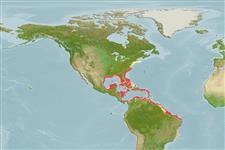Common names from other countries
>
Eupercaria/misc (Various families in series Eupercaria) >
Lutjanidae (Snappers) > Lutjaninae
Etymology: Lutjanus: Malay, ikan lutjan, name of a fish.
More on author: Walbaum.
Environment: milieu / climate zone / depth range / distribution range
Ökologie
seewasser; brackwasser riff-verbunden; tiefenbereich 2 - 63 m (Ref. 9626). Subtropical; 42°N - 19°S, 98°W - 31°W (Ref. 55)
Western Atlantic: north to Massachusetts, USA (rare in Florida) and south to Trinidad and northern Brazil.
Length at first maturity / Size / Gewicht / Alter
Maturity: Lm 25.0 range ? - ? cm
Max length : 79.1 cm FL Männchen/unbestimmt; (Ref. 69373); common length : 35.0 cm TL Männchen/unbestimmt; (Ref. 55); max. veröff. Gewicht: 10.8 kg (Ref. 26340); max. veröff. Alter: 42 Jahre (Ref. 128039)
Rückenflossenstacheln (insgesamt) : 10; Rückenflossenweichstrahlen (insgesamt) : 14; Afterflossenstacheln: 3; Afterflossenweichstrahlen: 8. Snout long and pointed, mouth large. One of the upper pairs of canine teeth notably enlarged, visible when mouth is close. Preopercular notch and knob weak. Pectoral fins long, reaching the level of anus. Scale rows on back parallel to lateral line, at least anteriorly. Olive gray to brownish on upper back and sides, with eight narrow, pale vertical bars which may be faint or absent in large adults. A solid or broken blue line which may disappear with growth, runs under the eye.
Adults occur in shallow, clear, warm, coastal waters over coral reefs. Often near the shelter of elkhorn corals and gorgonians (Ref. 9710). Juveniles are encountered over sand bottoms with or without seagrass (Thalassia), and over muddy bottoms of lagoons or mangrove areas. Young sometimes enter brackish waters. Sometimes form resting aggregations during the day. Feed on fishes, shrimps, crabs, worms, gastropods and cephalopods. Considered a good food fish, it is marketed fresh or frozen (Ref. 55). Maximum length for female taken from Ref. 3093.
Allen, G.R., 1985. FAO Species Catalogue. Vol. 6. Snappers of the world. An annotated and illustrated catalogue of lutjanid species known to date. FAO Fish. Synop. 125(6):208 p. Rome: FAO. (Ref. 55)
IUCN Rote Liste Status (Ref. 130435)
CITES (Ref. 128078)
Not Evaluated
Bedrohung für Menschen
Reports of ciguatera poisoning (Ref. 30911)
Nutzung durch Menschen
Fischereien: kommerziell
Tools
Zusatzinformationen
Download XML
Internet Quellen
Estimates based on models
Preferred temperature (Ref.
115969): 23.3 - 28, mean 26.4 (based on 412 cells).
Phylogenetic diversity index (Ref.
82804): PD
50 = 0.5000 [Uniqueness, from 0.5 = low to 2.0 = high].
Bayesian length-weight: a=0.01479 (0.01312 - 0.01668), b=2.97 (2.95 - 2.99), in cm Total Length, based on LWR estimates for this species (Ref.
93245).
Trophic level (Ref.
69278): 4.3 ±0.4 se; based on diet studies.
Widerstandsfähigkeit (Ref.
120179): niedrig, Verdopplung der Population dauert 4,5 - 14 Jahre. (Preliminary K or Fecundity.).
Prior r = 0.60, 95% CL = 0.39 - 0.89, Based on 1 data-limited stock assessment.
Fishing Vulnerability (Ref.
59153): High vulnerability (62 of 100).
